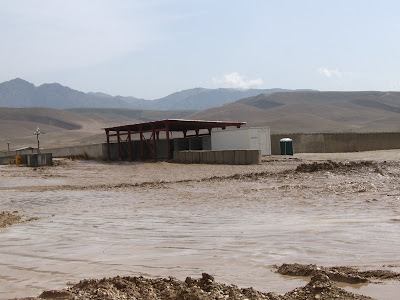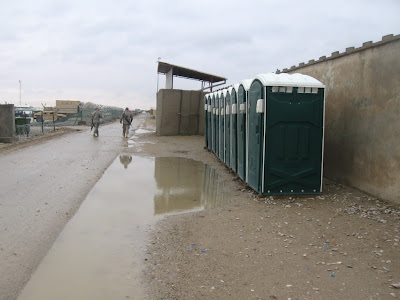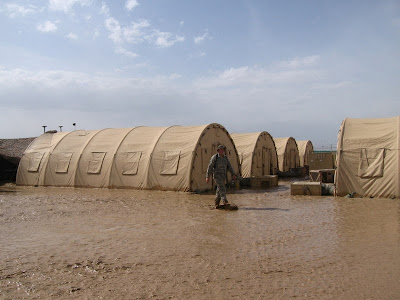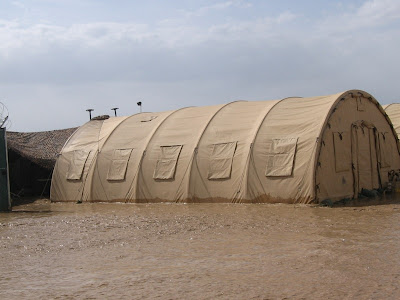As annoying as it may be to fend against the steady accumulation of dust/dirt particles indoors, at least it is generally harmless to wooden or plastic furniture. It poses a much more serious problem to the electronics needed for basic operations here.
I’ll admit that I’ve been remiss in cleaning my computer top, partly to make a point, so the environment in that photo above is a bit contrived. But imagine how long it would take to achieve this level of dust accumulation in most environments in the US. Here’s a co-worker’s desk:
And here is a more authentic depiction of dust patterns on a laptop that I use—one that I have cleaned with pressurized air about two weeks ago.
Compare the keys that are commonly used (most letters) with those that generally remain untouched (the function keys at the top row, or the letter Z) to see what even a couple days of accumulation can achieve. It has undeniably caused the demise of some expensive machinery, and I have no doubt that particles of soil effectively killed the camera I referenced in a recent post.
And yet these wearying images and descriptions are only indicative of the soil conditions in Afghanistan during the dry climate. When the soil is wet, which is often the case during the rainy season (running from late January to mid April), it offers an entirely different array of unpleasant burdens.
In early April, we received an early morning sprinkle over the course of maybe two or three hours, though never enough to justify an umbrella by most people’s standards. The photo above and several below demonstrate the aftermath. Sure, they're just puddles, but puddles wouldn’t typically form after a sprinkle, even accounting for the relative imperviousness of the gravel base. The conditions are far worse in other locations.
For the most part, the soil here does not support anything more than scrappy, intermittent herbs and grasses, which is the yin to this abiotic yang. If the earth grew more plants, their root systems would facilitate drainage, but since the soil’s percolation ability is poor—characteristic, no doubt, of the Psamment suborder mentioned earlier—most plants simply can’t grow. These helicopter views are poor quality, for which I apologize, but it still manifests the conditions in Afghanistan after a minor shower, which is generally all we get here:
It looks like a mud slide engulfed the city of Mazar-e-Sharif, but this just shows the typical conditions after rain—an endless sheet of beige slime, punctuated by occasional grasses (but only during the spring growing season). Viewed from the ground, the ponding is much worse in one of the lower points of Bear Village, the American Army compound at Camp Marmal:

The poor folks who live in these tents have to deal with days of standing water; it only diminishes through evaporation, and in the peak of the rainy season (which this year was February) minor sprinkles occur every few days. Although the rocks would seem to impede drainage, the gravel bed is the only preventative measure to keep pedestrians from slurping through ankle-deep mud. Witness these slippery stairs nearby:

And the conditions on the less heavily graveled side of that wall:
Puddles emerge after even the mildest of rains—and virtually all rains in Afghanistan are insignificant, yet they are hardly ever inconsequential: the mildest ones still take at least a full day to evaporate, remarkable given the arid nature of the climate through much of the year. Drainage simply does not occur to any measurable degree. Thus, the German engineers who first broke ground at Camp Marmal several years ago decided to build a full array of drainage ditches, partially visible in this earlier blog post, to prepare for no more than a half-dozen modest drizzles over a four-month rainy season in the late winter and early spring. The rest of the time, those ditches will sit idle.
Thus, the engineers and planners for this base had to invest in a drainage system to prepare for a situation that usually occurs no more than a half dozen times each year. And many years the rainy season passes by without a real thunderstorm. It seemed like 2011 was going to be one of those years, but around the 10th of April, just days before the anticipated end of all measurable rain, Balkh province in Afghanistan got pummeled. Well, not really: the storm was no more than a half hour of moderate rain; not enough to make people in Louisiana open their umbrellas. But it was significant enough for this arid country. The immediate aftermath of a shower at this scale is predictable, given the conditions of the soil:

Ponding is especially problematic in the back of these tents, where the HVAC systems and circuit breakers rest. Fortunately it didn’t appear too bad this time:
But it was more than enough to fill those roadside drainage ditches:

And elsewhere, the water just sat in pools atop the nearly impermeable mud.

It turned out this was just the prelude to our apocalypse. About an hour later, as the sky was fully brightening, we encountered this unpleasantness:

Water had come surging down the mountainside, accumulating velocity and volume as gravity took its course, so that the landlocked tsunami forced its way through the opening formed by the base’s Commercial Entry Control Point (ECP), continuing on down what used to be a road—a paved one, mind you:

At the next major intersection, the low point formed by two streets allowed the water to disperse…
…right into our compound.
Sandbags worked as valiantly as possible, but they were no match for these water levels, some of which easily topped a foot in height. The sandbags on the closest side of this tent were completely submerged.
Here is the front of our row of tents, after the flood had peaked and begun to recede:
And the back, where it mercifully appears that the Environmental Control Units (ECUs) weren’t badly affected:
While our one-acre compound bore the brunt of the flooding because of our proximity to the Commercial ECP, other parts of the base felt the impact as well. The large drainage swale, empty 96% of the year, came close to topping over.
Fortunately the engineering for this swale is superior to that of these smaller channels, which exceeded their capacity, resulting in some minor water intrusion in the back portion of the American gym:
Though the channel below looks unremarkable as a static image, the water had crested above its banks just 30 minutes earlier, and the flow speed at the time of this photo was still so fast that a person falling in would likely result in a drowning.
And, of course, combining all that water with the infuriating Afghan soil results in one ubiquitous condition: ankle-deep mud. The photos below show the conditions the next day, approximately twenty-four hours after the rainshower:
And inside the tents, which, at the time of this photo, were in the process of being dismantled:
It’s hard to capture depth or thickness of such a large planar surface with a camera, but let it be known that if one’s boots were not tied tightly enough, the suction of that thick stew would easily pull them off. After wading through it for just a few minutes, a person would come out two inches taller, with newly formed platform shoes.

It took three twelve-hour days to restore most of our compound, which truthfully was probably not a long time considering the vast amount of work to be done. It could have been much worse: no tent received more than 16 inches of water and, most importantly, no one was hurt. But it remains a curiosity to most Americans that it happened at all. The rain volume, even for a largely arid environment, were not particularly severe, and yet it elicited flash flood conditions at the base. My suspicion is that the intensity of the rain was much greater in the nearby Hindu Kush mountains, which would help to explain the deceptively large surge that came barreling down the slope and hour later. The change in grade also undoubtedly intensified the velocity at which the water tumbled down. But the soil remains the key player; its imperviousness contributed to both the volume and the speed of the run-off. By no means does Camp Marmal have the greatest drainage infrastructure: as mentioned in a previous blog on cost-cutting measures at military outposts, it's hard to justify the steep expenditures for a top-of-the-line flood prevention system at a base which its creators never intended to be permanent. Nonetheless, one can only imagine what the permanent Afghan population has to contend with during the rainy season: according to a report on the province of Balkh released by the Afghanistan Ministry of Rural Rehabilitation and Development, only 49% of the province's households have electricity, 31% have access to safe drinking water, and only 12% can access safe toilet facilities. Incidentally, Balkh's standard of living ranks much higher than most other provinces in the country, thanks to the presence of a large city such as Mazar-e-Sharif. Within the urbanized areas in and around this nation's fourth-largest city, the above statistics are superior: 95% of households have electricity, 67% have safe drinking water, and 15% have safe toilets. However, like most of Afghanistan, Balkh is significantly rural, and remote settlements lacking good infrastructure are abundant. If systems for providing water are scarce or poor quality, it is reasonable to suspect that water removal and drainage are also less than advanced. We've experienced what happens on base during a minor rainstorm. How do the Afghans manage?
The soil in Afghanistan is a palpable impediment to the nation's citizens' ability to attain a higher standard of living. Those who live in cities like Mazar-e-Sharif still sometimes maintain garden plots outside the urbanized areas; the aforementioned report reveals that 40% of households in Balkh province depend on agriculture as the primary source of income, either through direct cultivation or trade. The parched climate and friable soil results in a remarkably short growing season for most grasses, suitable for the nomadic ethnic Pashtuns known has Kuchis, but undeniably a challenge for more permanently settled populations. Though the cultivation and consolidation of food no longer precludes urbanization in most developed nations, it most likely plays a role in Afghanistan's ranking as one of the world's most rural countries, with only 23% of the population living in urbanized areas. The dust impedes operationality of electronics, making it an unlikely place to attract foreign technological investment, a barrier further exacerbated by the incredibly low literacy rate (less than 30%, and barely 10% for women). The filmy layer of soil makes routine living for outsiders unacquainted with these levels of dust—which includes practically everyone—a constant frustration. It's miserable in the dry season and impedes visibility enough to pose potential problems for air travel, while eclipsing those mountain views much of the time. A person is never far from a spectacular mountain range, but he or she can often only see it half the year, as indicated by the visibility rates in the chart below:

My experience of southern Afghanistan around Kandahar was that it was even worse than Mazar-e-Sharif. Down there, everyone I spoke to felt as though the hands need washing every five minutes. And, of course, the rains, as rare as they are, not only elicit pools of muddy water in the best of times and catastrophic flooding at the worst, they render many of the roadways impassable—a tremendous problem in a region where only 38% of the roads can handle car traffic in all seasons. A mud-filled unpaved road is unusable.
Is there a region in North America at all comparable to Afghanistan? A superficial research of climatological patterns—an admitted problem when I understand northern Afghanistan's climate far better than my native country—suggests to me some parts of the US might share at least remotely similar pedological characterstics. The temperature and rainfall data for Mazar-e-Sharif in the charts below, as well as the previous visibility chart, comes from the Joint Meteorological and Oceanographic Climatology Segment from the Department of Defense. (I wish I had included this material in Part I of this essay, when I referenced temperature and moisture regimes, but at least I've managed to integrate it to Part II before it goes to post.)
In the US, from the information I could determine, the region that most closely mimics Afghanistan's alternating mountain/desert plateau topography falls, not surprisingly, in the West. But much of the Rockies receive far more precipitation, or the temperatures are far more consistently warm or cool than the extremes that Afghanistan experiences. The best that I could determine is that northern and central Nevada—a virtually waterless region that includes only a half-dozen counties (Humboldt, Churchill, Pershing, Lander, Elko, Eureka, White Pine) but covers a significant land mass (about half of the state)—may have soil that most closely resembles that of Afghanistan, in terms of the moisture and temperature regimes. However, north-central Nevada does not exactly meet the war-torn southwest Asian country's demographics.
While Afghanistan has a land area comparable to and a population somewhat larger than the state of Texas, northern Nevada (approximately 55,000) is virtually uninhabited. The largest communities in this region, are Elko, Fallon, and Winnemucca, which only total approximately 30,000 people. The famed U.S. Route 50-- “the Loneliest Road in America”--bisects the region. If it were to quintuple in size, which is about what it would take to be comparable to Afghanistan, it would still have fewer than a half million people. Afghanistan, by contrast, has a landscape more austere and certainly just as rural, but it claims a population of nearly 30 million. Obviously the distinguishing factors between northern Nevada and Afghanistan—which include birth rates, colonization histories, stability of governments, sovereignty and enforceable boundaries, among other things—are complicated enough to generate an entirely different article. Suffice it to say, though, that population distribution in the US has proven that, given the choice, a significant portion of America has not found northern Nevada suitable or desirable for settlement, where as Afghanistan's similarly unforgiving landscape hosts more people than any US state but California.
The soil conditions in this war-torn, remote—yet hardly unpopulated—country are just the tip of the iceberg in terms of impediments to long-term prosperity. By many metrics, Afghanistan enjoyed a higher standard of living under monarchy in the 1960s and 1970s than it does today. The Soviet occupation throughout the 1980s fostered an additional soil condition that prove a bigger onus to Afghan quality of life than any dust piles or flash floods: the land mines buried within. The statistics for the country are grim. According to the 2010 Landmine Monitor, Afghanistan had the highest number of casualties in the world, at 859—over 20% of the world's total. It is one of the five most mine-enriched countries, with an estimated 10 million total, so that every square mile of the country averages 40. The popular site Listverse estimates that mines kill or maim an estimated 10 to 12 people every day in Afghanistan. Fortunately, the country also benefits from some of the most intensive mine clearance initiatives in the world: Landmine Monitor reports that it ranked top globally in 2009 and the square kilometers of mine area cleared there comprise nearly 30% of the global total. Nonetheless, land mines will inevitably impede any other form of investment, until they are eradicated, which could easily take decades—while assuming that no other events will throw the demining process off course, or, inshallah, foster a new reason for planting land mines. This article may depict the living conditions in Afghanistan as bleak, thanks to its infuriating soil. However, the relics of war—and land mines are hardly a relic since they perpetuate a culture of conflict-related casualties long after a treaty has been signed—transcend most if not all of the intrinsic pedalogic features. Who knows—after the nation is liberated from its broadly scattered landmine catastrophe, maybe that moon dust will seem like small potatoes.

































